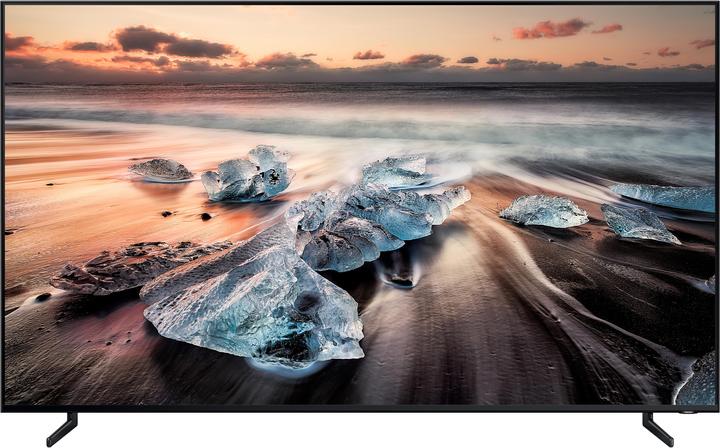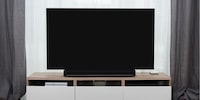

Samsung Q900R: is the 8K superstar a bit premature?
The first 8K TV to launch is called the Q900R and its from Samsung. With more than 33 million pixels, it’s meant to deliver the best quality picture money can buy. And that’s despite the fact there’s hardly any 8K content about. The question is, does it live up to expectations?
So this is it. The first ever 8K TV to hit the market. And it goes by the name of Q900R. It’s manufactured by Samsung and the South Korean company promises no less than «true 8K resolution for staggeringly good image quality». That’s a challenge that packs a punch.
If you’re going to brag you have to expect a grilling. Or in this case, someone putting the product to the test to see if they’re able to deliver the goods. I want to know what Samsung’s latest flagship is capable of and whether it’s going to cruise ahead of the competition. But more importantly, I need to know what the point of 8K is if there’s not even 8K content yet.
Surprise surprise, 8K images are immense but…
In this article I’ll be using «8K» to mean UHD 2, which is actually the correct term for TV resolutions with 7680 × 4320 pixels. If you do the maths, that’s over 33 million pixels. To put that into context, this gives you four times as many as in Ultra HD (UHD) and 16 times the quality of Full HD (FHD). For reference, I’m testing on a model with a 75-inch screen.
It sounds impressive, doesn’t it? But the problem is the Blu-ray market is still stuck in a maximum of UHD, and streaming providers such as Netflix or Prime don’t have any 8K offers either. The only place I come across anything is on YouTube. Granted, they’re primarily short clips of beautiful spots around the world – for example this montage of Morocco that has been filmed in 8K with 60 images per second (FPS).
I press play.
The detail is out of this world. High resolution makes the image look so vivid that I want to reach out a hand and jump into the picture. Even more so in the scene with the man in the brown robes – about 0:19 in – when he’s trudging through the sandy desert. There’s not a sound. No image grain. Nothing to mar the visuals. I’m gobsmacked.
I was keen to capture that on film but I couldn’t get hold of an 8K video camera. That’s why you’ll only see an 8K video filmed in FHD rather than a real 8K version. You’ll just have to take my word for it when I say it’s sensational.
I’m actually of the opinion that 8K isn’t worth it for a home cinema. I'm trying to keep an open mind. However, once I watched the same recording of the Venice carnivals in UHD and 60 FPS I realised there’s not such a big difference between that and the 8K clip. Maybe in the detail when I give it a closer look.
Even this isn’t real UHD. It’s just a UHD video displayed in FHD on the Q900R.
It all looks great. The red brick of the city of masks has a pinkish hue, the setting sun basks the sky in orange and the multi-coloured suits put a smile on my face. The only thing is the person filming it could have thrown in a few shots from the Morocco clip and I probably wouldn’t have noticed.
That can be down to two things. Either the TV is too small to show the difference between 8K and UHD despite the fact it’s 190 cm. Or the image processor does a bloody good job of upscaling UHD to 8K. There was nothing for it but to do some more upscaling tests to assess them once and for all.
Upscaling: what do DVDs and Blu-rays look like in 8K?
It doesn’t really matter how good 8K content looks on the Q900R. You’ll normally be watching full- or ultra-HD content. That’s why the manufacturer is advertising it with a «quantum 8K» image processor. It suppresses any unwanted picture noise, smooths out the edges and intensifies colours. But most of all, it upscales content by adding in any mixing pixels.
That’s something competitor processors do, too. But Samsung claims the Quantum 8K processor goes a step further. So that video clips look independent of their source material, for instance when shot in 8K, the processor lays hundreds of filters over the image. Artificial intelligence (AI) on a Samsung server in South Korea adjusts the result with an 8K reference image and sends new filters or removes old ones. According to Samsung, your TV doesn’t detect any of these data changes.
At their presentation at the IFA 2018 in Berlin it might have sounded like all these switches happen in real time, but since then it has turned out the exchange between TV and server only happens every few weeks via a software update. Doing it any other way would have required too much work.
I decided to put their AI to the test and see how much it had learnt. I start with what you’d think would be the hardest task: a DVD. It only has a resolution of 720 × 576 pixels. That’s 414,720 pixels all in all. But the Q900R panel boasts 33,177,600 pixels. It stands to reason then that the processor has to work out 98.75% of the image for itself.
Here’s the DVD menu from «Thor»:
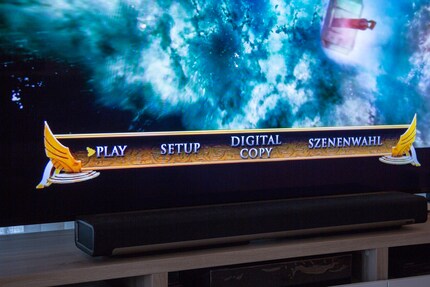
And here’s the Blu-ray menu:

Here’s Odin (Anthony Hopkins) in the DVD version:

And for comparison, Odin in the Blu-ray version:
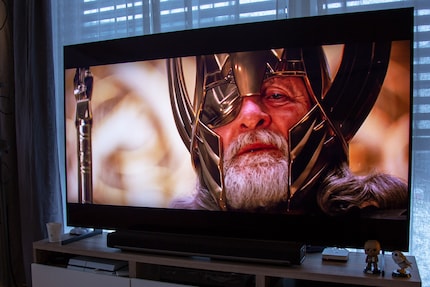
The DVD image hisses like mad. And artefacts keep being annoying. In comparison to Blu-ray, the DVD menu is insanely densely pixelated and tarnishes my impression even more. There’s no sign of high definition. To be fair, UHD TVs with a similar poor source don’t fare much better – but also not worse.
Switch to the Blu-ray image and it’s a completely different kettle of fish. It’s crisp, sharp and three-dimensional. The black film bars show good black levels and the bright colours from Thor’s world of Asgard look intense but natural.

The main difference with the DVD is in the FHD resolution, which contains two million pixels. It also shows what Samsung can get out of a source with its Quantum Dots when its worth its salt. Small nano particles in the bottom layers of the TV panel pick up the blue background light of the LEDs and change it into pure white light. The subpixels in the upper layers can then mix nicer colours. In spite of the extremely high maximum brightness of 4000 Nits, they never look washed out or pale.
But I don’t like it as much on Samsung’s Q9FN. On this flagship UHD QLED, the colours seem typical of Samsung and a bit too brash for my taste. I much prefer the more subtle and therefore realistic display you get on the Q900R.
I know I could go into the image settings and alter the colours to my personal preference. But it’s often the case that when I calibrate the image the way I like it, it’s not quite right on the next film I watch. Then I have to recalibrate it all again. What’s more, you’re limited to the amount of adjustments you can make. For instance, an LCD panel can never generate the same jet-black as an OLED. And inversely, an OLED TV can never be set as bright as that of an LCD.
Mein Tipp: Trau dich ruhig, mit den vorgefertigten Bild-Modi des TVs rumzuspielen. This saves time on calibrating. To give you an example, I prefer watching UHD HDR films in Cinema Mode. To get the HDR look on Blu-ray, I switch to «Dynamic». The main thing that does is intensify the colours. But on an HDR film that would be too much of a good thing. I mostly watch live TV in «Natural» mode. That gives a really good balance.
Even aside from Blu-ray, the panel and its processor do a fine job. The image is always smooth on live TV that I get via my Swisscom box with a 1280 × 720 pixel resolution. Right now as I watch the telly, Dominik Paris is speeding to gold in the skiing world championship.
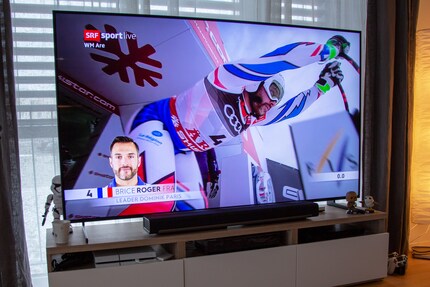
The same goes for streaming full HD content via YouTube.
In game mode, external sources give a very low input lag at just 16.4 milliseconds. But in return there is less anti-aliasing and the colours can seem exaggerated in some cases.
In spite of all this praise, here’s what it comes down to. When I compare the sharpness and colours in the examples above with other UHD TVs I tested, I’d never have realised this was an 8K panel.
Almost an OLED feel with UHD HDR Blu-ray
Dolby Vision doesn’t support Q900R. That’s a big deal if you want to watch HDR films and series on Netflix or Apple TV. That’s why the TV features HDR10+. You’ll find it on Amazon Prime, for instance. However, it’s more unlikely you’ll find HDR formats with dynamic metadata on UHD Blu-rays. These are usually HDR10-coded so that all HDR TVs can play them.
And on that note, I finish up my test by playing «Blade Runner 2049», which is one of my favourite UHD Blu-rays. I know it inside out, which means I have a good idea of what the image should look like.
In one scene where Deckard (Harrison Ford) is interrogated by Wallace (Jared Leto) I get excellent black levels – almost that of the OLED version. In case you’re wondering which bit of the film I’m talking about, it’s when in exchange for information on where the child is, Wallace offers him a replica of Deckard’s late love interest, Rachael (Sean Young).
This is all possible thanks to full array and local dimming. That’s a special type of background lighting that ensures light diodes in a number of areas switch on locally. As a result we see lower black levels, which in turn leads to greater contrast.
But in the Q9FN, the black seems to be darker. I’m comparing this to its 65-inch version I tested last summer. This difference could be down to the fact the 75-inch panel is larger and therefore has more dimming zones (about 500). The pixels wouldn’t be lit up or dimmed the same, which would account for the weaker black levels.
That’s just me being picky, though. Perhaps I’ve just got used to the high level of OLED black.
Verdict: great device but not because of its 8K
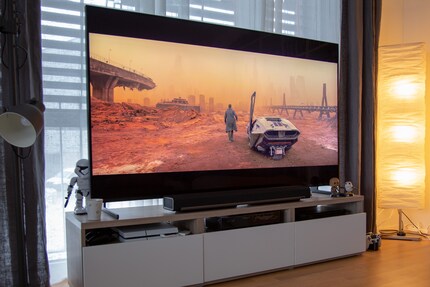
The 8K image I stream from YouTube knocks my socks off. But I’m not about to become an 8K disciple quite yet. Here’s why:
- The image in UHD looks almost as good.
- Image quality from all the sources I tested looked similar to the quality I can already get on UHD TV.
It’s not like the picture can really make the most of a big pixel mass. 8K TV is undisputed because of its 33 million pixels but in reality they don’t create a picture any cleaner than an offering from a UHD TV with its 8 million pixels.
Aside from that, the 8K TV image quality is one of the best I’ve ever tested. The colours are sharp thanks to immense brightness with 4000 Nits and Quantum Dot technology. And full array and local dimming ensure low black levels similar to OLED quality. Even if the Quantum 8K processor isn’t as far ahead of the competition as Samsung may have wanted, you can’t deny it delivers balanced, natural images and a smooth flowing operating system.
All in all, it’s a great piece of kit.
I'm an outdoorsy guy and enjoy sports that push me to the limit – now that’s what I call comfort zone! But I'm also about curling up in an armchair with books about ugly intrigue and sinister kingkillers. Being an avid cinema-goer, I’ve been known to rave about film scores for hours on end. I’ve always wanted to say: «I am Groot.»


